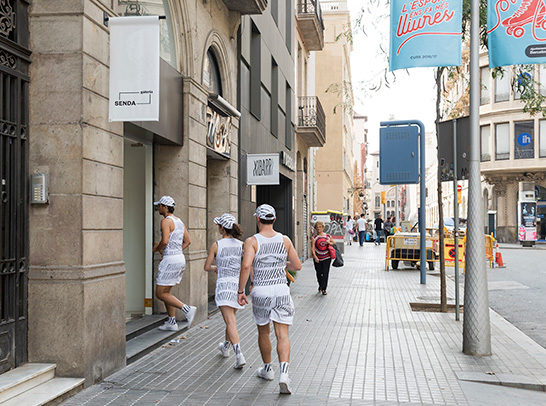
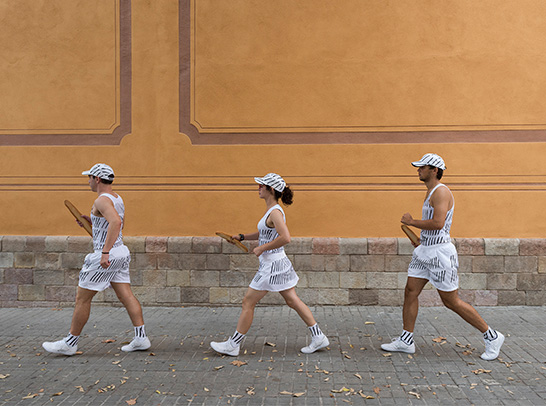
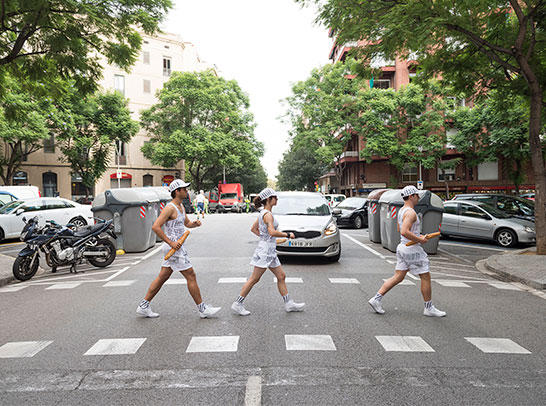
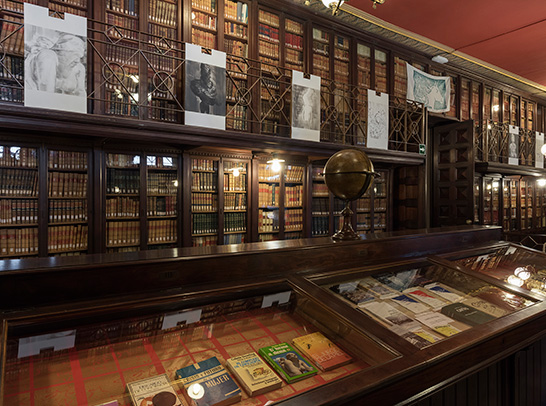
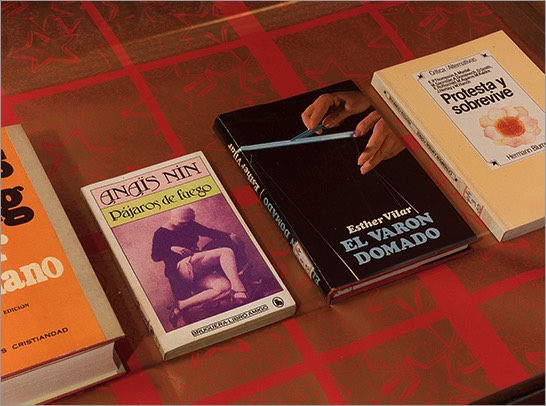
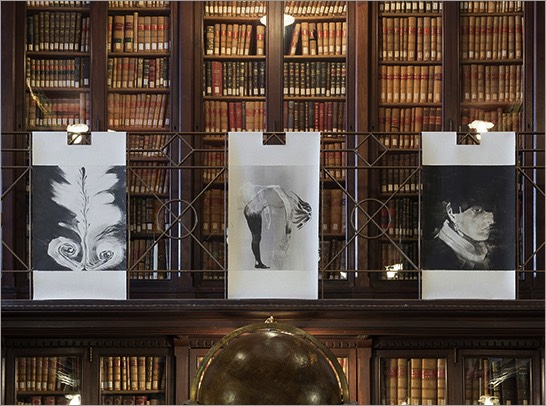
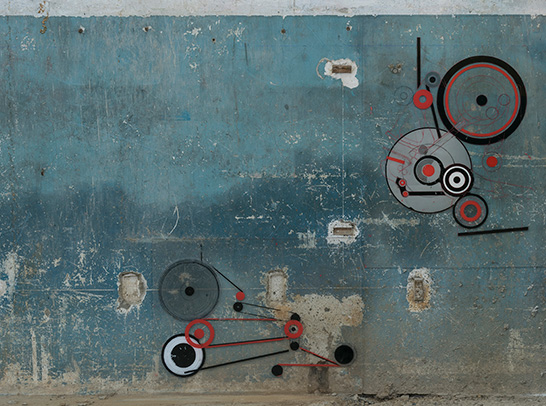
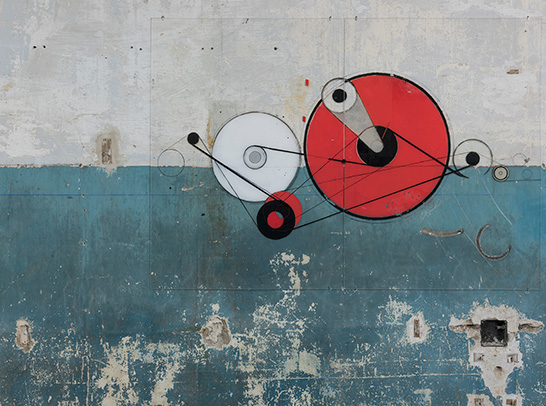
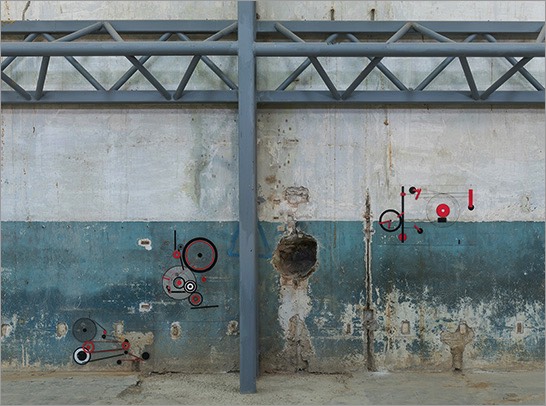
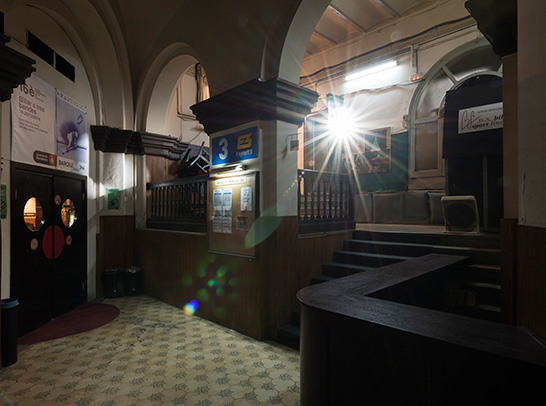
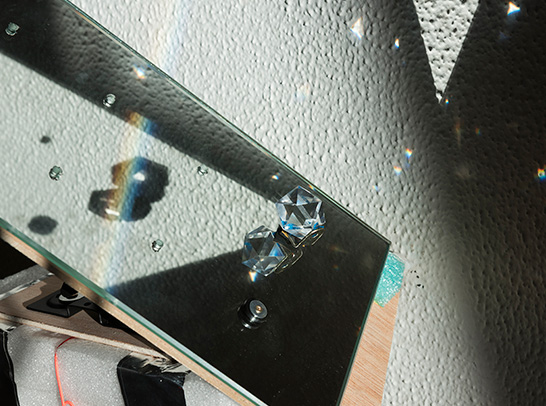
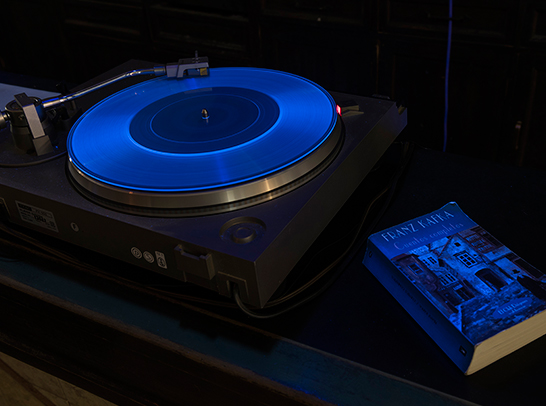
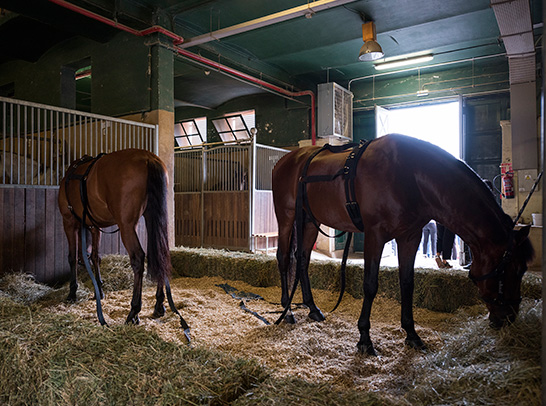
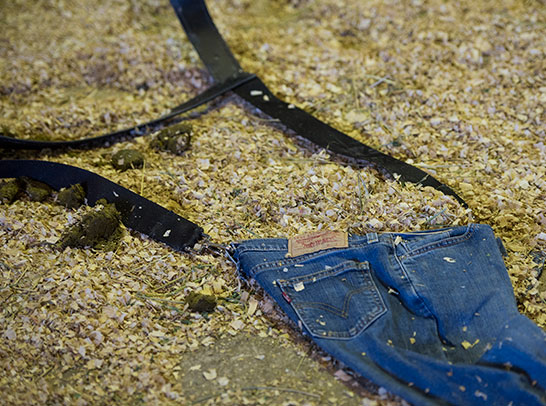
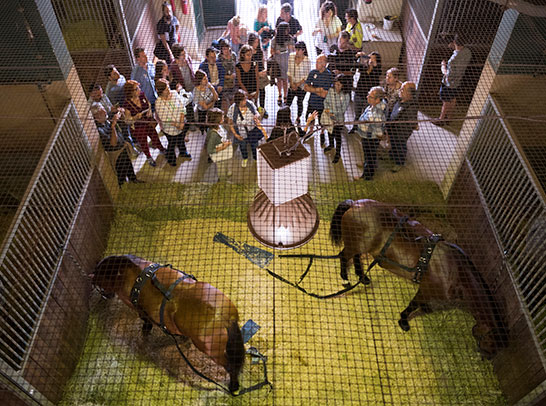
Curators
Compositions
Barcelona Gallery Weekend, various locations, Barcelona, 29 September–2 October 2016
Commissions by: Lúa Coderch (at the Barcelona Billards Club); Regina Giménez (at the former textile factory Can Trinxet, L’Hospitalet de Llobregat); Lola Lasurt (at the Biblioteca Pública Arús); Robert Llimós (connecting all the participating galleries) and Wilfredo Prieto (at the Mounted Unit of the Barcelona City Police).
The second edition of ‘Compositions’ (see 2015 edition) presented five new city-wide site-responsive commissions in civic and private venues. Each intervention gave texture and specificity by offering moments of intermission, intimacy and bewilderment, highlighting some lesser-known aspects of the city’s cultural heritage and municipal history.
Conceived and curated by Latitudes for the second time, each of the projects further explored Barcelona as a rich fabric of the historic and the contemporary, the unfamiliar and the conspicuous. Resisting an overall theme and instead developing from the artists’ responses to the specificity of each site—people as well as places—the five art projects formed a temporary thread linking evocative locations and civic spaces, running parallel to the Barcelona Gallery Weekend’s activities.
The second edition of ‘Compositions’ (see 2015 edition) presented five new city-wide site-responsive commissions in civic and private venues. Each intervention gave texture and specificity by offering moments of intermission, intimacy and bewilderment, highlighting some lesser-known aspects of the city’s cultural heritage and municipal history.
Conceived and curated by Latitudes for the second time, each of the projects further explored Barcelona as a rich fabric of the historic and the contemporary, the unfamiliar and the conspicuous. Resisting an overall theme and instead developing from the artists’ responses to the specificity of each site—people as well as places—the five art projects formed a temporary thread linking evocative locations and civic spaces, running parallel to the Barcelona Gallery Weekend’s activities.
↪ Lúa Coderch
Barcelona Billards Club
Lúa Coderch’s intervention for the programme brings a mysterious and improbable apparition to life in the home of the Club de Billar Barcelona. Beneath the Teatre Coliseum in Gran Vía there is a rainbow. Coderch guides sunlight and a spectrum of colours down into the underground gaming space with a series of precisely positioned mirrors and prisms, as if evoking the mechanics, geometry and artistry involved in billiards. Accompanying the rainbow is a turntable and a transparent vinyl record that can be used to play an audio recording of a female voice. This voice narrates and interprets what can be seen in front of us, and the process that led to its appearance. The title of her intervention, ‘The Rainbow Statement’ (2016), refers to one of the verbal tricks used by fortune-tellers and clairvoyants in “cold reading” an individual’s life or personality. Suggestively nebulous assertions maximise the chance of apparently specific and meaningful paranormal insights hitting the mark. ‘The Rainbow Statement’ is either an experiment of the imagination or a phenomenon of optical science with which Coderch seems to have invented a form of psychic meteorology, or spectral physics.
Sunday 2 October, 12am: Guided visit by Lúa Coderch and Latitudes at the Club Billar Barcelona, Gran Via de les Corts Catalanes, 595-599.
With the collaboration of David Merino and Eladi Sánchez. With thanks to: Miquel Casademunt, Jordi Figueras, Santiago Royo, Santiago Vallmitjana and Roberto Macovez.
Sunday 2 October, 12am: Guided visit by Lúa Coderch and Latitudes at the Club Billar Barcelona, Gran Via de les Corts Catalanes, 595-599.
With the collaboration of David Merino and Eladi Sánchez. With thanks to: Miquel Casademunt, Jordi Figueras, Santiago Royo, Santiago Vallmitjana and Roberto Macovez.
Lúa Coderch (Iquitos, Perú, 1982) obtained an MA in Artistic Production and Research (2012) and a degree in Fine Arts at the Universidad de Barcelona (2010). Amongst her individual exhibitions are: ‘Night in a Remote Cabin Lit By a Kerosene Lamp’, Galería Àngels Barcelona (2015); ‘Or’, Fundació Suñol, Barcelona (2014–2015); ‘La parte que falta’, Galería Bacelos, Madrid (2014); ‘La muntanya màgica’, Espai 13, Fundació Joan Miró, Barcelona (2013–14). She has participated in the following group shows: ‘¿Por qué no lo llamas entropía?’, Edición 0 Encuentro de Cultura Contemporánea de Guadalajara, México (2015); ‘The World of Interiors’, The Green Parrot, Barcelona (2014), ‘El futuro no espera’, La Capella, BCN Producció (2014). Coderch is represented by galería Bacelos (Madrid/Vigo) and àngels barcelona.
The Club Billar Barcelona (Barcelona Billiards Club) was founded in 1928 in its current location, the basement of the old Coliseum in Gran Vía – a cinema that was built in 1923 and converted into a theatre in 2006. The Club Billar Barcelona is the governing body of billiards clubs in Spain and currently has around 60 members. The many trophies that fill its vitrines are evidence of the dozens of national and international titles won by members of the club. These include over twenty cups for the championships of La Liga Española a Tres Bandas (Spanish Carom Billiards League) and seven for the European Championships of Carom Billiards for teams. The Club Billar Barcelona has six tables for carom billiards for the enjoyment of its members and four others available for the general public, as well as two pool tables. Since 1990, it organises the annual trophy “Trofeu Ciutat de Barcelona”.
↪ Regina Giménez
Can Trinxet, former textile factory, L’Hospitalet de Llobregat
The manufacturing and printing of textiles formed the basis of the industrial revolution in Catalunya. Beyond the actual fabric, it is the machinery of its production and the people who operated it—especially women—that underpins Regina Giménez’s presentation of her graphic works as part of the Compositions programme. Taking place in one of the buildings that comprises Can Trinxet, a former textile factory complex that once employed the largest workforce in L’Hospitalet de Llobregat, Giménez’s intervention comprises painted compositions that are derived from schematic representations of machines and their components. Her abstractions have been applied on transparent panels that lean against a scarred factory wall, becoming devices that reanimate the marks and memories embedded in the building. An accompanying poster evokes the clamour that once would have filled the workshop in typographic form. Giménez has titled her project “La Constancia” (2016) in tribute to the labor union that called a general strike in 1913 to protest the conditions of the female and child workers who undertook the textile industry’s most monotonous and arduous tasks.
Friday 30 September, 12am: Guided visit by Regina Giménez and Latitudes at the former factory Can Trinxet, c/ Santa Eulàlia 182–212, L’Hospitalet de Llobregat.
With thanks to: Ajuntament de Hospitalet de Llobregat, Albert Mercadé, Martí Anson.
Friday 30 September, 12am: Guided visit by Regina Giménez and Latitudes at the former factory Can Trinxet, c/ Santa Eulàlia 182–212, L’Hospitalet de Llobregat.
With thanks to: Ajuntament de Hospitalet de Llobregat, Albert Mercadé, Martí Anson.
Regina Giménez (Barcelona, 1966) has exhibited individually at: ‘Architecture d’aujourd’hui’, The Green Parrot, Barcelona (2015); ‘Art de foc art de badoc’, Nadala 2015 Fundació Joan Miró, Barcelona (2015); ‘Simbols Convencionals’, Museu d’Art Modern de Tarragona (2012). She has recently participated in the following group shows: Biennal de Valls, Tarragona (2015); ‘Modernitat Amagada’, Casa Capell, Mataró (2013); ‘La casa de la playa’ para ‘Cas de estudi’, Can Felipa, Barcelona (2013).
Giménez is represented by Ana Mas Projects, L’Hospitalet/San Juan (Puerto Rico) and by Galería Miquel Alzueta, Barcelona.
Giménez is represented by Ana Mas Projects, L’Hospitalet/San Juan (Puerto Rico) and by Galería Miquel Alzueta, Barcelona.
Designed in 1905, Can Trinxet was a factory for cotton yarn and fabric that operated until the beginning of the 1980s. For many years it was the factory that provided the most jobs in L’Hospitalet – in 1923 it employed 1,155 workers (45% of the city’s workforce), of which 863 were women. Despite its current deterioration and the profound modifications it has undergone, it is still considered one of the finest examples of industrial architectural heritage in the area, as much for its importance in textile production in L’Hospitalet as for its social value in terms of labour and union history in the district of Santa Eulàlia. Can Trinxet was principally known for producing white sheets, but also made tablecloths and corduroy for dying, including the popular golden-brown corduroy uniforms of the workers of the Companyia de Tramvies (Tram Company of Barcelona).
↪ Lola Lasurt
Biblioteca Pública Arús (Arús Public Library)
In her intervention, Lola Lasurt has collaborated with the Biblioteca Pública Arús, a study centre founded in 1895 with outstanding collections related to the labour movement, anarchism, Freemasonry and Sherlock Holmes. The project centres on a series of grisaille paintings forming a pictorial frieze that hangs from the balcony above a presentation of books in the Arús’s display cases. Under the title ‘Donació’ (Donation), 2016, Lasurt departs from 135 publications that once formed the personal library of Assumpta Corbera Santanach that were gifted in 2010 to the Arús after her death. Corbera Santanach identified as a feminist and a Freemason; she was not a public figure. Yet the impulse of Lasurt’s project is not primarily biographic or historiographic, but bibliographic and pictorial. Accordingly, ‘Donació’ attempts to narrate changes in social and cultural attitudes through the selection and redrafting of images that appear on the pages of the bibliographic bequest. Treating the publications as an intimate accumulation of ‘alternative’ knowledge and a representation of a self-education, Lasurt is interested in the portrayal of a private political imagination in the midst of what is now a public collection.
Thursday 29 September, 6pm: Guided visit by Lola Lasurt and Latitudes at the Biblioteca Pública Arús, Passeig de Sant Joan, 26.
With thanks to: Biblioteca Pública Arús [Maribel Giner i Molina (Director); David Domènech i Baró (Librarian); Mª Dolores Fernández Serrano and Josefa Ferrando Ruiz (Front Desk); Gabriela García Neuer (Administration)]; Celorama SL; Círculo Téxtil; Estel.la and Maragda Estany Corbera; Salvador Estany.
Thursday 29 September, 6pm: Guided visit by Lola Lasurt and Latitudes at the Biblioteca Pública Arús, Passeig de Sant Joan, 26.
With thanks to: Biblioteca Pública Arús [Maribel Giner i Molina (Director); David Domènech i Baró (Librarian); Mª Dolores Fernández Serrano and Josefa Ferrando Ruiz (Front Desk); Gabriela García Neuer (Administration)]; Celorama SL; Círculo Téxtil; Estel.la and Maragda Estany Corbera; Salvador Estany.
Lola Lasurt (Barcelona, 1983) studied Fine Arts (2005) at the Universitat de Barcelona and obtained a postgraduate in Aesthetics and Contemporary Art Theory, Universitat Autònoma Barcelona (2007) and an MA in Artistic Production and Research (2009). She has been resident at HISK, Ghent; La Ene, Buenos Aires and at the Greatmore Art Studios, Cape Town. She has exhibited individually at ‘Promenade’, 105 Besme, Brussels (2015); ‘Exercici de ritme’, Galeria Joan Prats, Barcelona (2015); ‘Doble autorización‘, as part of the exhibition cycle ‘Arqueología preventiva’, Espai 13, Fundació Joan Miró, Barcelona (2014); ‘Amnèsies’, Espai2, Terrassa (2012), ‘El Gegant Menhir’, Museu Joan Abelló, Mollet del Vallès (2011). Amongst her group shows are ‘Young Belgian Art Prize 2015’, Bozar, Brussels (2015); ‘Write of Spring’, Het Paviljoen, Ghent (2014); ‘Narrativas domésticas: más allá del álbum familiar’, Visiona, Huesca (2013); ‘Los inmutables’, DAFO, Lleida (2012); ‘La gran aventura’, Can Felipa, Barcelona (2012); ‘Learn and Teach’, Greatmore Art Studios, South Africa (2012). Lasurt is represented by Galeria Joan Prats, Barcelona.
Founded in 1895 as a bequest of philanthropist, activist, man of theatre and freemason Rossend Arús (1844–1891), the Biblioteca Pública Arús (Arús Public Library) is located in the flat in Barcelona’s Passeig Sant Joan where he lived.
Entrusted specifically to the people of Barcelona, it was the most advanced Catalan public library of its time, with facilities and a flexible timetable designed to accommodate working people. Over time and with the historical vicissitudes (in particular after the Spanish Civil War, 1936–1939), the Library has become a research centre specialised in social and cultural history of the 19th and early 20th centuries, with outstanding collections related to the labour movement, anarchism, Freemasonry and Sherlock Holmes.
Entrusted specifically to the people of Barcelona, it was the most advanced Catalan public library of its time, with facilities and a flexible timetable designed to accommodate working people. Over time and with the historical vicissitudes (in particular after the Spanish Civil War, 1936–1939), the Library has become a research centre specialised in social and cultural history of the 19th and early 20th centuries, with outstanding collections related to the labour movement, anarchism, Freemasonry and Sherlock Holmes.
↪ Robert Llimós
Connecting participating galleries
Robert Llimós presents a new version of an action that was originally created in the summer of 1972. One of the very few performative works of an artist primarily known for his paintings and sculptures, ‘Los Corredores’ (The Runners), was first realized as part of the legendary avant-garde art festival known as Los Encuentros de Pamplona (The Pamplona Meetings). On that occasion, three people dressed in identical running gear speed-walked throughout the city, connecting the various venues of the festival. As his project for the Composiciones programme, Llimós’s Los Corredores is now restaged on the streets of Barcelona. Three athletes criss-cross the city, seemingly rushing to see every venue of the Gallery Weekend. As in Pamplona, the white sports kits have been adorned by Llimós with black diagonal brushstrokes that symbolize the idea of painting. At times the speed-walking trio carry flowers, at others carry a baguette, or have their ankles joined with elastic ribbon—a painting-as-workout that has left the studio for the street with decoration, discipline, and a dynamic sense of urgency.
Friday 30 September, 5pm: Guided visit by Robert Llimós and Latitudes. Meeting point: BlueProject Foundation, c/Princesa 57.
With thanks to: Bruna Costa; Taller Vallirana and the runners Marta Bassart, Jaume Arija, Anna Sevilla and Diego del Castillo.
Friday 30 September, 5pm: Guided visit by Robert Llimós and Latitudes. Meeting point: BlueProject Foundation, c/Princesa 57.
With thanks to: Bruna Costa; Taller Vallirana and the runners Marta Bassart, Jaume Arija, Anna Sevilla and Diego del Castillo.
Robert Llimós’s (Barcelona, 1943) long trajectory as a painter and sculptor began in the sixties within the Nueva Figuración (New Figuration) movement (1965-1968). Between 1969-1973 he went through a more conceptual phase returning to figurative painting with a greater emphasis on colour. His work has been exhibited individually at the Museum Bochum, Germany (1994), Galería Alejandro Sales, Barcelona (2009); Fundació Vila Casas, Barcelona (2010). in 1972 he was part of the landmark international avant-garde art festival Encuentros de Pamplona (The Pamplona Encounters), as well as participating in the unofficial programme of Documenta 5, Kassel. He has exhibited in institutions such as the Museo del Barrio, Nueva York (1976 and 1978); Fundació Miró, Barcelona (1979, 1983 and 1992); Museu d’Art Contemporani de Barcelona (1996, 1997 and 2005); Museo Reina Sofía, Madrid (2004 and 2009) and the Fundació Suñol, Barcelona (2010), amongst others. Since 2009 Llimós has been producing work depicting extraterrestrial life forms and flying objects. In 1994 the Generalitat de Catalunya awarded him the Fine Arts Award. Two of his public sculptures can be seen in Barcelona: ‘Marc’ (1997) in the Olympic area and ‘Mirastels’ (2006) a floating sculpture in the Port of Barcelona. Llimós is represented by Galería Alejandro Sales, Barcelona.
↪ Wilfredo Prieto
Mounted Unit of the Barcelona City Police
Conceived by Wilfredo Prieto as his project for the Composiciones programme, ‘Pantalones rotos’ (Torn Jeans), 2012, is realised by the horses of the Guàrdia Urbana de Barcelona. The action-sculpture takes place at the Mounted Unit’s stables, a historic venue next to the city zoo that is not normally open to the public and whose exercise paddock is overlooked by the twin towers of the Torre Mapfre and Hotel Arts. In his work Prieto makes reference to an image which appears on the tag of every pair of classic Levi’s denim jeans—two horses trying in vain to break a pair of the reinforced trousers. Since their invention in 1873, Levi Strauss & Co.’s famous copper-riveted denim has become synonymous with the working people of the western United States—cowboys, lumberjacks, and railroad workers. Yet in ‘Pantalones rotos’, this symbol of the American frontier myth has been already torn apart with bathos as two harnessed horses each drag one half of a torn pair of jeans.
Saturday 1 October, 12am: Guided visit by Latitudes at the Unitat Muntada de la Guàrdia Urbana, c/ Wellington s/n (Opposite the tram terminus Ciutadella–Vil·la Olímpica)
With thanks to: Lena Solà Nogués; the Mounted Unit of the Barcelona City Police [Salvador Pallarès (General Director); Agustín Méndez (Sergeant); Gemma Mina (Saddler and harness maker); Adolfo Martínez (Horseman); and the horses Solero and Tulio (grey), Hércules and Aguileño (chesnut)].
Saturday 1 October, 12am: Guided visit by Latitudes at the Unitat Muntada de la Guàrdia Urbana, c/ Wellington s/n (Opposite the tram terminus Ciutadella–Vil·la Olímpica)
With thanks to: Lena Solà Nogués; the Mounted Unit of the Barcelona City Police [Salvador Pallarès (General Director); Agustín Méndez (Sergeant); Gemma Mina (Saddler and harness maker); Adolfo Martínez (Horseman); and the horses Solero and Tulio (grey), Hércules and Aguileño (chesnut)].
Wilfredo Prieto (Sancti Spiritus, Cuba, 1978) pursued art studies at the Instituto Superior de Arte (Higher Institute of Fine Arts ISA), graduating in 2002. Prieto’s recent solo exhibitions include: ‘Ping Pong Grid’, Museo Nacional de Bellas Artes, Havana, Cuba (2015); ‘Speaking Badly about Stones’, S.M.A.K, Ghent, Belgium (2014); ‘Incidences from the Private to the Public and from the Public to the Private’, NMAC Foundation, Cádiz, Spain (2013); ‘Leaving Something to Chance’, Sala de Arte Público Siqueiros, México (2012); ‘Balancing the curve’, Hangar Bicocca, Milan, Italy (2012); ‘Amarrado a la pata de la mesa’, Centro de Arte 2 de Mayo (CA2M), Móstoles, Madrid (2011); and has participated in group shows such as ‘Under the same sun: Art from Latin America Today’, Guggenheim Museum, Nueva York (2014); ‘Coup d’éclat, En résonance’, Biennale d'art contemporain de Lyon, Francia (2009); ‘Untitled’, 12th Istanbul Biennial, Turquía (2009). Prieto has been awarded the Cartier Award (Frieze Art Fair, London, 2008) and the UNESCO Prize for the Promotion of the Arts (2000). Prieto’s work is represented by NoguerasBlanchard, Barcelona/Madrid; Annet Gelink Gallery, Amsterdam and kurimanzutto, Mexico City.
The Mounted Unit of the Barcelona City Police performed for the first time in November 1856. Currently the Unit carries out both policing and ceremonial work. It provides guard duties and protection for citizens, as well as crowd management and escorting during popular festivities such as the Procession of the Three Kings. For the latter type of ceremonial acts, the riders wear a formal uniform of red jackets and silver helmets with crests of white feathers. At times the riders carry a musical instrument to perform as the Band of the Barcelona City Police.
The Unit’s policemen care for and train the 38 horses under their charge in the Stables of the Ciutadella Park, a building originally constructed to house the Gallery of Machines during the 1888 Universal Exhibition. Throughout the year the Mounted Unit performs different carousels for events such as the festivities of La Mercè, the patron saint of Barcelona, or the Open Day celebrating the patron saint of the City Police, in addition to other appearances on a national and international level. Performed since 1910, the carousel is an equine exercise in which riders parade on horseback and form shapes to the rhythm of music. In 2016 the Mounted Unit celebrates its 160th anniversary.
The Unit’s policemen care for and train the 38 horses under their charge in the Stables of the Ciutadella Park, a building originally constructed to house the Gallery of Machines during the 1888 Universal Exhibition. Throughout the year the Mounted Unit performs different carousels for events such as the festivities of La Mercè, the patron saint of Barcelona, or the Open Day celebrating the patron saint of the City Police, in addition to other appearances on a national and international level. Performed since 1910, the carousel is an equine exercise in which riders parade on horseback and form shapes to the rhythm of music. In 2016 the Mounted Unit celebrates its 160th anniversary.
#Composiciones2016
#BarcelonaGalleryWeekend
#LosCorredores1972
Intervention by Lúa Coderch:
Club Billar Barcelona
Gran Via de Les Corts Catalanes 595–599, 08007 Barcelona
Opening hours:
29 Sept: 5–9pm
30 Sept, 1 and 2 Oct: 11am–7pm
Public transport:
M: Passeig de Gràcia (L2, L3, L4)
B: 7, 50, 54, 67, 68, H12
Intervention by Regina Giménez:
Antigua fábrica textil Can Trinxet
c/ Santa Eulàlia 182–212, 08902 L’Hospitalet de Llobregat
Opening hours:
29 Sept: 5–9pm
30 Sept, 1 and 2 Oct: 11am–7pm
Public transport:
M: Santa Eulàlia o Torrassa (L1)
B: L16, L52, L82, L85, LH1, N13
Intervention by Lola Lasurt:
Biblioteca Pública Arús
Pg Sant Joan 26, 08010 Barcelona
Opening hours:
29 Sept: 5–9pm;
30 Sept: 11am–7pm;
1 Oct: 11am–2pm;
2 Oct: CLOSED;
3 and 4 Oct: 11am–6pm;
Public transport:
M: Arc de Triomf (L1)
Rodalies: R1, R3, R4 Arc de Triomf
B:19, 51, 55, B20, B25, N4, N11
Intervention by Robert Llimós:
Connecting all the participating galleries
Opening hours:
29 Sept: 5–9pm
30 Sept, 1 and 2 Oct: 11am–7pm
Intervention by Wilfredo Prieto:
Mounted Unit of the Barcelona City Police
c/ Wellington, s/n (opposite the tram 4 terminus, Ciutadella–Vil·la Olímpica), 08018 Barcelona
Opening hours:
29 Sept: CLOSED
30 Sept, 1 and 2 Oct: 11–12h*
[*Doors open 10:30h daily. Photo ID required.]
Public transport:
M: Vil·la Olímpica (L4)
T: Ciutadella–Vil·la Olímpica (T4)
B: 36, 59, 92, N0, V21, V27
Mediators:
Anna Casaña, Mireia Pons, Silvia Lorenz, Meritxell Ferré, Hana Boukalam, Júlia Escudero, Carla Blanco, Martina Mefano, Mariona Bonet, Marta Sellarés, Mireia Oltra, Sofía Giménez.
Photographic documentation:
Roberto Ruiz
Special thanks to Glòria Pou, Lídia González Alija and Andrea Martínez at the Barcelona Gallery Weekend office and to its Executive Committee. Our heartfelt thanks to Gina, Lola, Lúa, Robert and Wilfredo.
‘Compositions’ is produced by the BGW, an initiative of:
Art Barcelona – Asociación de Galerías de Arte Contemporáneo Art Barcelona.
Supported by:
Ajuntament de Barcelona (ICUB), the Generalitat de Catalunya (ICEC), the Ajuntament de L’Hospitalet de Llobregat and AC/E Acción Cultural Española, as well as private sponsors and individual patrons.
#BarcelonaGalleryWeekend
#LosCorredores1972
Intervention by Lúa Coderch:
Club Billar Barcelona
Gran Via de Les Corts Catalanes 595–599, 08007 Barcelona
Opening hours:
29 Sept: 5–9pm
30 Sept, 1 and 2 Oct: 11am–7pm
Public transport:
M: Passeig de Gràcia (L2, L3, L4)
B: 7, 50, 54, 67, 68, H12
Intervention by Regina Giménez:
Antigua fábrica textil Can Trinxet
c/ Santa Eulàlia 182–212, 08902 L’Hospitalet de Llobregat
Opening hours:
29 Sept: 5–9pm
30 Sept, 1 and 2 Oct: 11am–7pm
Public transport:
M: Santa Eulàlia o Torrassa (L1)
B: L16, L52, L82, L85, LH1, N13
Intervention by Lola Lasurt:
Biblioteca Pública Arús
Pg Sant Joan 26, 08010 Barcelona
Opening hours:
29 Sept: 5–9pm;
30 Sept: 11am–7pm;
1 Oct: 11am–2pm;
2 Oct: CLOSED;
3 and 4 Oct: 11am–6pm;
Public transport:
M: Arc de Triomf (L1)
Rodalies: R1, R3, R4 Arc de Triomf
B:19, 51, 55, B20, B25, N4, N11
Intervention by Robert Llimós:
Connecting all the participating galleries
Opening hours:
29 Sept: 5–9pm
30 Sept, 1 and 2 Oct: 11am–7pm
Intervention by Wilfredo Prieto:
Mounted Unit of the Barcelona City Police
c/ Wellington, s/n (opposite the tram 4 terminus, Ciutadella–Vil·la Olímpica), 08018 Barcelona
Opening hours:
29 Sept: CLOSED
30 Sept, 1 and 2 Oct: 11–12h*
[*Doors open 10:30h daily. Photo ID required.]
Public transport:
M: Vil·la Olímpica (L4)
T: Ciutadella–Vil·la Olímpica (T4)
B: 36, 59, 92, N0, V21, V27
Mediators:
Anna Casaña, Mireia Pons, Silvia Lorenz, Meritxell Ferré, Hana Boukalam, Júlia Escudero, Carla Blanco, Martina Mefano, Mariona Bonet, Marta Sellarés, Mireia Oltra, Sofía Giménez.
Photographic documentation:
Roberto Ruiz
Special thanks to Glòria Pou, Lídia González Alija and Andrea Martínez at the Barcelona Gallery Weekend office and to its Executive Committee. Our heartfelt thanks to Gina, Lola, Lúa, Robert and Wilfredo.
‘Compositions’ is produced by the BGW, an initiative of:
Art Barcelona – Asociación de Galerías de Arte Contemporáneo Art Barcelona.
Supported by:
Ajuntament de Barcelona (ICUB), the Generalitat de Catalunya (ICEC), the Ajuntament de L’Hospitalet de Llobregat and AC/E Acción Cultural Española, as well as private sponsors and individual patrons.
Archives
- Reseña – Pablo Santa Olalla, "Postconceptualismos en el Barcelona Gallery Weekend”, postpostpost.org, 23 Octubre 2016
- Reseña – Javier Díaz-Guardiola, “Pulsos que se ganan o se pierden”, ABC cultura, 10 octubre 2016
- Video – Programa Àrtic, Josep Paris, BTV, 3 octubre 2016 (entre min. 14.08–21.35)
- Reseña – Montse Frisach, “Art, un missatge no rebut”, El Punt Avui, 1 octubre 2016
- Reseña – Mar Rocabert, Cinc obres d’art que s’escapen de la galeria aquest cap de setmana, El País, 29 Setembre 2016
- Video – Arrenca el Gallery Weekend amb exposicions a les galeries barcelonines, Telenoticies TV3, 29 Setembre 2016 (min. 01:28 – Lola Lasurt)
- Reseña – Vanessa Graell, “Fuera del “white cube””, Suplement Tendències, El Mundo, 29 Setembre 2016
- Reseña – Eugènia Sendra, 'Composicions': los otros espacios del Barcelona Gallery Weekend, Time Out, 27 Setembre 2016
- Video – Tria33, Laura Sangrà, 26 Setembre 2016
- Reseña – Nicholas Forrest, “Sneak Peek: Barcelona Gallery Weekend 2016”, BlouinArtinfo, 20 September 2016
- Project News – 'Compositions' a programme of five artists' interventions for the second Barcelona Gallery Weekend, 29 September–2 October 2016, 20 September 2016
- Reseña – Javier Díaz-Guardiola, “Citas para incluir en la agenda: Composiciones”, núm 5, ABC cultura, 3 Septiembre 2016
- Reseña – Això és el que veurem a la segona edició del Barcelona Gallery Weekend, Time Out, 24 d’agost 2016
- Out of Office – Latitudes' "out of office" 2016–2017 season, 1 August 2017
- Cover Story – Cover Story: July 2016 – Through the grapevine – Rasmus Nilausen’s Soups & Symptoms, 3 July 2016
- Project News – Barcelona Gallery Weekend 2016 – Artists and locations of the programme "Composiciones” announced, 21 June 2016